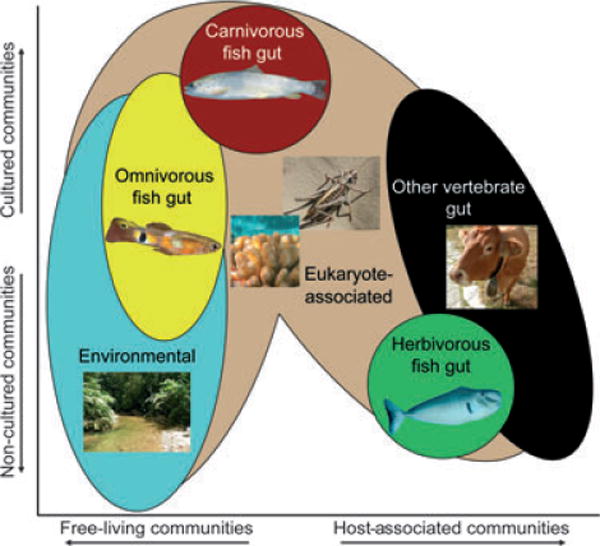Fig. 1.

Similarity among gut bacterial communities in fishes from different trophic levels compared to non-fish-associated bacterial communities from various sources. This figure is a representation of a PCoA from fig. 3 in Sullam et al. (2012). Bacterial communities vary along the X-axis (PCoA1) according to their associations with organisms. Environmental bacteria, from both aquatic and terrestrial habitats, fall on the left-hand side of the X-axis (represented by blue area). Bacterial communities derived from eukaryotic animal hosts tend to fall further right along the X-axis (represented by beige area), with gut communities from mammals and other vertebrates found furthest right (represented by black area). Herbivorous fish gut bacterial communities (represented by green area), which were all derived from marine species, are more similar to mammalian gut bacterial communities. In contrast, omnivorous fish gut bacterial communities (represented by yellow area) are more similar to environmental samples, and carnivorous fish bacterial communities (represented by red area) are more similar to those found in insects and other eukaryotic habitats. Bacterial communities also differentiate along the ϒ-axis (PCoA2) depending in part on whether they are derived from culture-based or culture-independent approaches. Photo credits: Omnivorous fish (Poecilia reticulata), Paul Bentzen; Carnivorous fish (Salmo trutta), Emilie Person; Herbivorous fish (Naso tonganus), Kendall Clements. Other pictures from left to right: Trinidadian stream, Karen Sullam; Coral from French Polynesia (Pocillopora verrucosa), Adrian Stier; Orthopteran, Karen Sullam; Cow, Karen Sullam.
